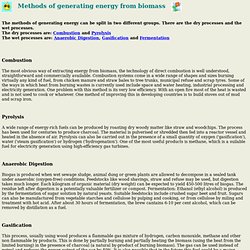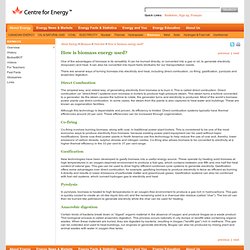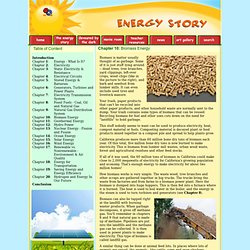

Energy Matters: Methods of Converting Biomass. As of July 1, 2013 ThinkQuest has been discontinued.

We would like to thank everyone for being a part of the ThinkQuest global community: Students - For your limitless creativity and innovation, which inspires us all. Teachers - For your passion in guiding students on their quest. Partners - For your unwavering support and evangelism. Parents - For supporting the use of technology not only as an instrument of learning, but as a means of creating knowledge. We encourage everyone to continue to “Think, Create and Collaborate,” unleashing the power of technology to teach, share, and inspire. Best wishes, The Oracle Education Foundation. FICHA11.pdf. Centre for Energy™ : How is biomass converted to energy? Methods. Methods of generating energy from biomass The methods of generating energy can be split in two different groups.

There are the dry processes and the wet processes. The dry processes are: Combustion and PyrolysisThe wet processes are: Anaerobic Digestion, Gasification and Fermentation Combustion The most obvious way of extracting energy from biomass, the technology of direct combustion is well understood, straightforward and commercially available. Pyrolysis A wide range of energy-rich fuels can be produced by roasting dry woody matter like straw and woodchips. Anaerobic Digestion Biogas is produced when wet sewage sludge, animal dung or green plants are allowed to decompose in a sealed tank under anaerobic (oxygen-free) conditions. Gasification This process, usually using wood produces a flammable gas mixture of hydrogen, carbon monoxide, methane and other non flammable by products.
Fermentation If the biomass used is (or can be converted into) mostly sugar, then yeast can be added. Advantages and Disadvantages of Biomass. Speaking of resources, the world changes pace everyday.

First there was evolution which took us from wood to steel to iron (and more), then development happened and took us to the stage that we are in now. Now we see that there are distinct shifts in policies which have taken us back to our roots and have been able to reacquaint us with the natural resources that we once used. Biomass.pdf (application/pdf Object) How Biomass Energy Works. Centre for Energy™ : How is biomass energy used? Previous | next One of the advantages of biomass is its versatility.

It can be burned directly, or converted into a gas or oil, to generate electricity (biopower) and heat. It can also be converted into liquid fuels (biofuels) for our transportation needs. There are several ways of turning biomass into electricity and heat, including direct combustion, co-firing, gasification, pyrolysis and anaerobic digestion. Direct Combustion The simplest way, and oldest way, of generating electricity from biomass is to burn it. Although this technology is dependable and proven, its efficiency is limited. Co-firing Co-firing involves burning biomass, along with coal, in traditional power plant boilers. Gasification New technologies have been developed to gasify biomass into a useful energy source.
Pyrolysis In pyrolysis, biomass is heated to high temperatures in an oxygen-free environment to produce a gas rich in hydrocarbons. The Energy Story - Chapter 10: Biomass Energy. Biomass is matter usually thought of as garbage.

Some of it is just stuff lying around -- dead trees, tree branches, yard clippings, left-over crops, wood chips (like in the picture to the right), and bark and sawdust from lumber mills. It can even include used tires and livestock manure. Your trash, paper products that can't be recycled into other paper products, and other household waste are normally sent to the dump. Your trash contains some types of biomass that can be reused. Recycling biomass for fuel and other uses cuts down on the need for "landfills" to hold garbage. This stuff nobody seems to want can be used to produce electricity, heat, compost material or fuels. Biomass Energy Pros and Cons - Energy Informative. Biomass is organic matter from plants and animals (microorganisms).

Photosynthesis is the name process that stores the energy from sunlight in plants. New96-819-No15.pdf (application/pdf Object) Biomass energy pros and cons in a nutshell. Biomass energy is a renewable energy source derived from biological materials that are called biomass.

As with all renewable energy sources biomass energy has its pros and cons. Biomass Fuels The most common sources of biomass are wood, waste of biological form (i.e. sawdust), animal manure, landfill gasses, biofuel crops (i.e corn) and garbage (Municipal Solid Waste). It should be noted that in the case of garbage and the waste to energy processes (i.e. burning municipal solid waste for the production of heat and/or electricity) it can only be considered renewable if the fuel used is purely of biological origin and does not contain any non-organic materials otherwise it cannot be considered sustainable.